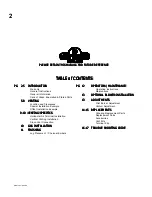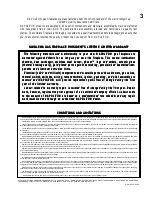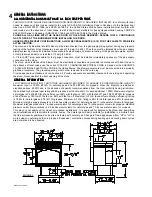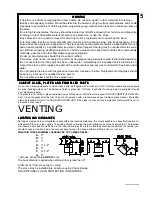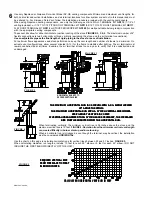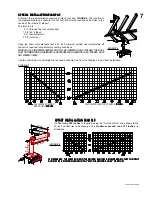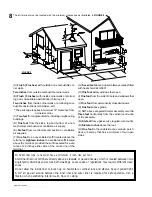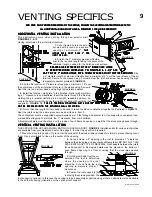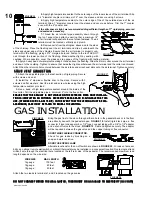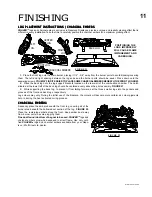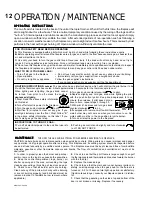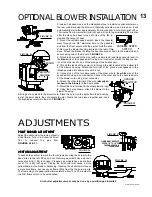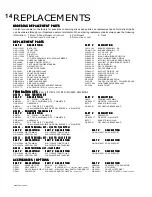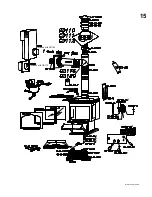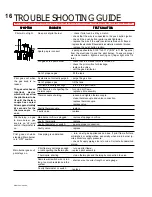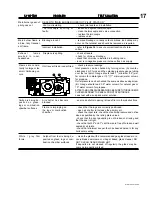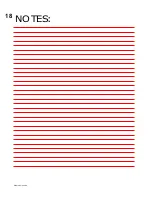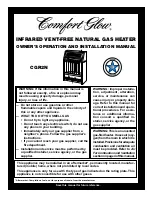
6
WS-415-63 / 11.24.98
Use only Napoleon or Simpson Dura-Vent Model DV-GS venting components. Minimum and maximum vent lengths, for
both horizontal and vertical installations, and air terminal locations for either system are set out in this manual and must
be adhered to. For Simpson Dura-Vent, follow the installation procedure provided with the venting components.
When using Napoleon venting components, use only the following vent kits: WALL TERMINAL KIT
GD175
(7-1/2' of
venting included), or 1/12 TO 7/12 PITCH ROOF TERMINAL KIT
GD110
, 8/12 TO 12/12 ROOF TERMINAL KIT
GD111
,
FLAT ROOF TERMINAL KIT
GD112
or STOVE PERISCOPE KIT
GD180
(for wall penetration below grade)
in conjunction
with the appropriate venting components.
These vent kits allow for either horizontal or vertical venting of the stove.
FIGURES 2, 3, & 4
. The maximum number of 4"
flexible connections is two horizontally or three vertically (excluding the stove and the air terminal connections).
Use an adjustable pipe as the final length of rigid piping to the stove for ease of installation.
For optimum flame appearance and stove performance, keep the vent length and number of elbows to a minimum. On
extreme vent configurations, allow several minutes (5-15) for the flame to stabilize after lighting. The air terminal must
remain unobstructed at all times. Examine the air terminal at least once a year to verify that it is unobstructed and
undamaged.
THE MAXIMUM HORIZONT
THE MAXIMUM HORIZONT
THE MAXIMUM HORIZONT
THE MAXIMUM HORIZONT
THE MAXIMUM HORIZONTAL RUN IS 34 INCHES WITH A 90
AL RUN IS 34 INCHES WITH A 90
AL RUN IS 34 INCHES WITH A 90
AL RUN IS 34 INCHES WITH A 90
AL RUN IS 34 INCHES WITH A 90
o
o
o
o
o
ELBOW LOCA
ELBOW LOCA
ELBOW LOCA
ELBOW LOCA
ELBOW LOCATED
TED
TED
TED
TED
29" ABOVE THE STOVE.
29" ABOVE THE STOVE.
29" ABOVE THE STOVE.
29" ABOVE THE STOVE.
29" ABOVE THE STOVE.
THE MAXIMUM HORIZONT
THE MAXIMUM HORIZONT
THE MAXIMUM HORIZONT
THE MAXIMUM HORIZONT
THE MAXIMUM HORIZONTAL RUN WITH A 57 INCH VERTICAL RISE IMMEDI-
AL RUN WITH A 57 INCH VERTICAL RISE IMMEDI-
AL RUN WITH A 57 INCH VERTICAL RISE IMMEDI-
AL RUN WITH A 57 INCH VERTICAL RISE IMMEDI-
AL RUN WITH A 57 INCH VERTICAL RISE IMMEDI-
A
A
A
A
ATEL
TEL
TEL
TEL
TELY ABOVE THE STOVE IS 20 FEET
Y ABOVE THE STOVE IS 20 FEET
Y ABOVE THE STOVE IS 20 FEET
Y ABOVE THE STOVE IS 20 FEET
Y ABOVE THE STOVE IS 20 FEET.....
IF VERTICAL RISES GREA
IF VERTICAL RISES GREA
IF VERTICAL RISES GREA
IF VERTICAL RISES GREA
IF VERTICAL RISES GREATER THAN 57 INCHES ARE NECESSARY
TER THAN 57 INCHES ARE NECESSARY
TER THAN 57 INCHES ARE NECESSARY
TER THAN 57 INCHES ARE NECESSARY
TER THAN 57 INCHES ARE NECESSARY, THE INCREASED
, THE INCREASED
, THE INCREASED
, THE INCREASED
, THE INCREASED
RISE MUST BE DEDUCTED FROM THE HORIZONT
RISE MUST BE DEDUCTED FROM THE HORIZONT
RISE MUST BE DEDUCTED FROM THE HORIZONT
RISE MUST BE DEDUCTED FROM THE HORIZONT
RISE MUST BE DEDUCTED FROM THE HORIZONTAL RUN.
AL RUN.
AL RUN.
AL RUN.
AL RUN.
When terminating vertically, the minimum vertical rise is 34 inches above the stove and the
maximum vertical rise is 15 feet.
FIGURE 4.
Deviation from the minimum vertical vent length
can create difficulty in burner start-up and/or carboning.
When a horizontal run is introduced, even though the terminal may be vertical, the installation
must be considered
HORIZONTAL
.
Use the chart on this page to calculate horizontal runs for vertical rises between 29 and 57 inches.
FIGURE 5.
When calculating maximum run lengths, include 10 feet for each 90° elbow or 5 feet for each 45° elbow. (DO NOT
INCLUDE THE FIRST ELBOW DIRECTLY OFF THE UNIT.)
HORIZONTAL RUN NOT TO
EXCEED VERTICAL RISE
FIGURE 2
FIGURES 3
REQUIRED VER
REQUIRED VER
REQUIRED VER
REQUIRED VER
REQUIRED VERTICAL RISE
TICAL RISE
TICAL RISE
TICAL RISE
TICAL RISE
FROM FIREPLACE TO FIRST
FROM FIREPLACE TO FIRST
FROM FIREPLACE TO FIRST
FROM FIREPLACE TO FIRST
FROM FIREPLACE TO FIRST
ELBOW IN
ELBOW IN
ELBOW IN
ELBOW IN
ELBOW IN INCHES
INCHES
INCHES
INCHES
INCHES
CALCULA
CALCULA
CALCULA
CALCULA
CALCULATED HORIZONT
TED HORIZONT
TED HORIZONT
TED HORIZONT
TED HORIZONTAL VENT RUN IN
AL VENT RUN IN
AL VENT RUN IN
AL VENT RUN IN
AL VENT RUN IN FEET
FEET
FEET
FEET
FEET
FIGURE 4
FIGURE 5


